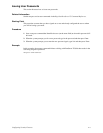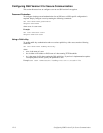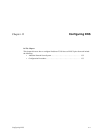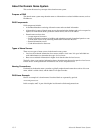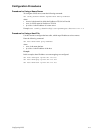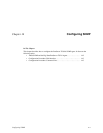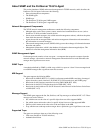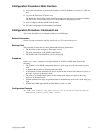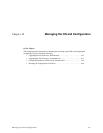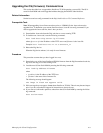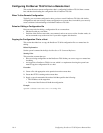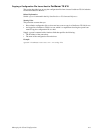14-2 About SNMP and the PortServer TS 8/16 Agent
About SNMP and the PortServer TS 8/16 Agent
This section introduces SNMP and network management in TCP/IP networks, and it describes the
PortServer TS 8/16 agent. It discusses the following:
• Network management components
• The SNMP agent
•SNMP traps
• The PortServer TS 8/16 agent’s MIB support
• The PortServer TS 8/16 agent’s supported traps
Network Management Components
The TCP/IP network management architecture contains the following components:
• Managed nodes such as host systems, routers, terminal and communications servers (such as
PortServer TS 8/16) and other network devices
• One or more network managers (also called network management stations), which are the points
from which the network is managed
• Agents that reside on managed nodes and retrieve management information and communicate
this information to network managers
• The network management protocol, SNMP, which governs the exchange of information between
the nodes and stations
• Management information, which is the database of information about managed objects. This
database is called the management information base (MIB).
SNMP Management Agent
Each managed node contains at least one agent—a component that responds to requests from the
network manager—that retrieves network management information from its node and notifies the
manager when significant events occur.
SNMP Traps
A mechanism defined by SNMP is called a trap, which is a report or “alarm” from a managed node
to an SNMP manager that a significant event has occurred.
MIB Support
The agent supports the following MIBs:
• Read-write for MIB II (RFC 1213), which is an Internet-standard MIB, consisting of managed
objects from the systems, interfaces, IP, ICMP, TCP, UDP, transmission, and SNMP group
• Read-write for the character-stream devices using SMIv2 MIB (RFC 1658)
• Read-write for the RS-232-like hardware devices MIB (RFC 1659)
• Read-write for the PortServer TS 8/16 IP Network Control Protocol of the Point-to-Point Proto-
col MIB (RFC 1473)
Message Support
The SNMP agent supports the Set, Get, GetNext, and Trap messages as defined in RFC 1157. These
messages are used as follows:
• Set, which means set the value of a specific object from one of the supported MIBs
• Get, which means retrieve the value of a specific object form one of the supported MIBs
• GetNext, which means retrieve the value of the next object in the MIB
• Trap, which means send traps to the manager when a particular type of significant event occurs
Supported Traps
The agent can send traps when any of the following occur:
• Cold starts (PortServer TS 8/16 initializes)
• Authentication failures




